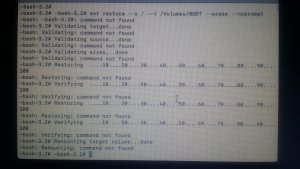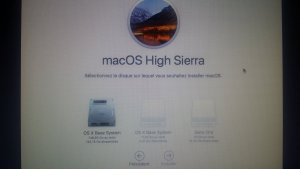-bash-3.2# -bash-3.2# diskutil eraseVolume free null disk3s3 ; diskutil resizeVolume disk3s2 0b ; diskutil resizeVolume disk3s2 20g jhfs+ BOOT 0b
-bash: -bash-3.2#: command not found
Started erase on disk3s3 BOOT
Unmounting disk
Finished erase on disk3
Resizing to full size (fit to fill)
Started partitioning on disk3s2 Sans titre
Verifying the disk
Verifying file system
Volume was successfully unmounted
Performing fsck_hfs -fn -x /dev/rdisk3s2
Checking Journaled HFS Plus volume
Checking extents overflow file
Checking catalog file
Checking multi-linked files
Checking catalog hierarchy
Checking extended attributes file
Checking volume bitmap
Checking volume information
The volume Sans titre appears to be OK
File system check exit code is 0
Restoring the original state found as mounted
Resizing
Modifying partition map
Growing file system
Finished partitioning on disk3s2 Sans titre
/dev/disk3 (external, physical):
#: TYPE NAME SIZE IDENTIFIER
0: GUID_partition_scheme *32.0 GB disk3
1: EFI EFI 209.7 MB disk3s1
2: AppResizing to full size (fit to fill)
Started partitioning on disk3s2 Sans titre
Error: -69743: The new size must be different than the existing size
Resizing to 20000000000 bytes and adding 1 partition
Started partitioning on disk3s2 Sans titre
Error: -69743: The new size must be different than the existing size
-bash-3.2# Started erase on disk3s3 BOOT
-bash: Started: command not found
-bash-3.2# Unmounting disk
-bash: Unmounting: command not found
-bash-3.2# Finished erase on disk3
-bash: Finished: command not found
-bash-3.2# Resizing to full size (fit to fill)
-bash: syntax error near unexpected token `('
-bash-3.2# Started partitioning on disk3s2 Sans titre
-bash: Started: command not found
-bash-3.2# Verifying the disk
-bash: Verifying: command not found
-bash-3.2# Verifying file system
-bash: Verifying: command not found
-bash-3.2# Volume was successfully unmounted
-bash: Volume: command not found
-bash-3.2# Performing fsck_hfs -fn -x /dev/rdisk3s2
-bash: Performing: command not found
-bash-3.2# Checking Journaled HFS Plus volume
-bash: Checking: command not found
-bash-3.2# Checking extents overflow file
-bash: Checking: command not found
-bash-3.2# Checking catalog file
-bash: Checking: command not found
-bash-3.2# Checking multi-linked files
-bash: Checking: command not found
-bash-3.2# Checking catalog hierarchy
-bash: Checking: command not found
-bash-3.2# Checking extended attributes file
-bash: Checking: command not found
-bash-3.2# Checking volume bitmap
-bash: Checking: command not found
-bash-3.2# Checking volume information
-bash: Checking: command not found
-bash-3.2# The volume Sans titre appears to be OK
-bash: The: command not found
-bash-3.2# File system check exit code is 0
-bash: File: command not found
-bash-3.2# Restoring the original state found as mounted
-bash: Restoring: command not found
-bash-3.2# Resizing
-bash: Resizing: command not found
-bash-3.2# Modifying partition map
-bash: Modifying: command not found
-bash-3.2# Growing file system
-bash: Growing: command not found
-bash-3.2# Finished partitioning on disk3s2 Sans titre
-bash: Finished: command not found
-bash-3.2# /dev/disk3 (external, physical):
-bash: syntax error near unexpected token `external,'
-bash-3.2# #: TYPE NAME SIZE IDENTIFIER
-bash-3.2# 0: GUID_partition_scheme *32.0 GB disk3
-bash: 0:: command not found
-bash-3.2# 1: EFI EFI 209.7 MB disk3s1
-bash: 1:: command not found
-bash-3.2# 2: Apple_HFS Sans titre 31.7 GB disk3s2
-bash: 2:: command not found
-bash-3.2# Resizing to 20000000000 bytes and adding 1 partition
-bash: Resizing: command not found
-bash-3.2# Started partitioning on disk3s2 Sans titre
-bash: Started: command not found
-bash-3.2# Verifying the disk
-bash: Verifying: command not found
-bash-3.2# Verifying file system
-bash: Verifying: command not found
-bash-3.2# Volume was successfully unmounted
-bash: Volume: command not found
-bash-3.2# Performing fsck_hfs -fn -x /dev/rdisk3s2
-bash: Performing: command not found
-bash-3.2# Checking Journaled HFS Plus volume
-bash: Checking: command not found
-bash-3.2# Checking extents overflow file
-bash: Checking: command not found
-bash-3.2# Checking catalog file
-bash: Checking: command not found
-bash-3.2# Checking multi-linked files
-bash: Checking: command not found
-bash-3.2# Checking catalog hierarchy
-bash: Checking: command not found
-bash-3.2# Checking extended attributes file
-bash: Checking: command not found
-bash-3.2# Checking volume bitmap
-bash: Checking: command not found
-bash-3.2# Checking volume information
-bash: Checking: command not found
-bash-3.2# The volume Sans titre appears to be OK
-bash: The: command not found
-bash-3.2# File system check exit code is 0
-bash: File: command not found
-bash-3.2# Restoring the original state found as mounted
-bash: Restoring: command not found
-bash-3.2# Resizing
-bash: Resizing: command not found
-bash-3.2# Shrinking file system
-bash: Shrinking: command not found
-bash-3.2# Modifying partition map
-bash: Modifying: command not found
-bash-3.2# Initialized /dev/rdisk3s3 as a 11 GB case-insensitive HFS Plus volume with a 8192k journal
-bash: Initialized: command not found
-bash-3.2# Mounting disk
-bash: Mounting: command not found
-bash-3.2# Finished partitioning on disk3s2 Sans titre
-bash: Finished: command not found
-bash-3.2# /dev/disk3 (external, physical):
-bash: syntax error near unexpected token `external,'
-bash-3.2# #: TYPE NAME SIZE IDENTIFIER
-bash-3.2# 0: GUID_partition_scheme *32.0 GB disk3
-bash: 0:: command not found
-bash-3.2# 1: EFI EFI 209.7 MB disk3s1
-bash: 1:: command not found
-bash-3.2# 2: Apple_HFS Sans titre 20.0 GB disk3s2
-bash: 2:: command not found
-bash-3.2# 3: Apple_HFS BOOT 11.5 GB disk3s3
-bash: 3:: command not found
-bash-3.2# -bash-3.2#



